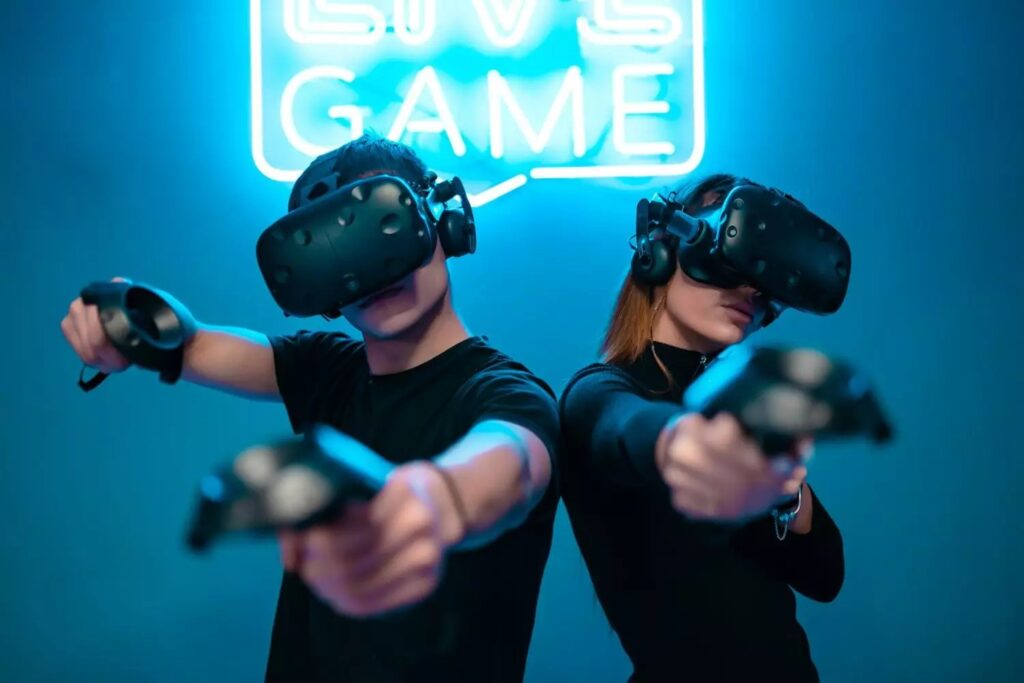The gaming industry is witnessing a major shift with the rise of virtual reality (VR) technology. VR gaming offers immersive experiences by simulating a three-dimensional environment that can be interacted with and explored. Advancements in technology and lower costs of VR headsets have contributed to the popularity of VR gaming, allowing players to physically move and interact with their surroundings. This level of immersion has the potential to revolutionize the gaming industry, pushing the boundaries of game design and mechanics. Additionally, VR gaming enhances social interactions and has applications beyond gaming in areas like education, healthcare, and engineering. Although there are technical challenges, the future of VR gaming looks promising.
The Future of Gaming: Virtual Reality and Immersive Experiences
Introduction
Over the past few decades, the gaming industry has evolved at an unprecedented pace. From basic 2D arcade games to highly sophisticated open-world adventures, gaming has become a multi-billion dollar industry that captivates millions of people worldwide. However, with the advent of virtual reality (VR) technology, a whole new era of immersive experiences is about to unfold.
What is Virtual Reality?
Virtual reality, often abbreviated as VR, refers to a computer-generated simulation of a three-dimensional environment that can be interacted with and explored by an individual. It typically involves the use of a specialized headset that encompasses the user’s field of vision, providing a sense of presence and immersion in a virtual world.
The Rise of VR Gaming
In recent years, VR gaming has gained significant traction, thanks to advancements in technology and plummeting costs of VR headsets. Gaming companies and technology giants, such as Oculus, HTC, and Sony, have launched VR platforms, enabling users to experience games in a whole new way.
Unlike traditional gaming, where players use a control pad or a keyboard and mouse, VR gaming requires players to physically move and interact with their surroundings. Sensors in the VR headset track the user’s movement, allowing them to walk, run, jump, and even crouch in the game environment.
As a result, VR gaming offers a level of immersion that has never been possible before. Players can feel like they are truly present in the game, fighting enemies, solving puzzles, or exploring fantastical worlds, all within the confines of their living rooms.
The Impact on Gaming Industry
The introduction of virtual reality technology into gaming is poised to revolutionize the industry. It has the potential to redefine the way people play games, breaking the boundaries between reality and the virtual world. Traditional gaming setups, though still immensely popular, might soon face stiff competition from VR gaming experiences.
One of the most significant advantages of VR gaming is the level of innovation it brings to game design and mechanics. Developers now have the opportunity to create games that fully utilize the capabilities of VR technology, pushing the boundaries of what is possible in terms of graphics, sound, and gameplay mechanics.
Additionally, VR technology has the potential to enhance social interactions in gaming. With the integration of multiplayer capabilities, players can connect with friends or strangers from around the world, and interact with them in virtual environments. This not only adds a social element to gaming but also creates opportunities for cooperative or competitive gameplay experiences.
Challenges and Opportunities
Technical Limitations
Despite the immense potential of virtual reality gaming, there are still several technical challenges that need to be addressed. The current generation of VR headsets is bulky, expensive, and often requires a high-powered computer or gaming console to function optimally.
Additionally, some players may experience motion sickness or discomfort due to the discrepancy between their physical movements and the virtual world. Furthermore, the VR gaming market is still relatively niche compared to traditional gaming, which limits the number of developers investing in VR game development.
The Future of VR Gaming
However, as technology advances and becomes more accessible, these challenges are expected to diminish. The ongoing development of standalone VR headsets, which do not require external computing power, may make VR gaming more accessible to a wider audience.
Furthermore, as the VR gaming market grows, more game developers will venture into this space, leading to the creation of compelling and diverse experiences. This increased competition could lead to further innovation, driving down costs and improving the overall quality of VR gaming experiences.
Applications Beyond Gaming
While VR gaming is undoubtedly the most prominent application of virtual reality technology, its potential reaches far beyond the gaming industry. Various industries, such as education, healthcare, engineering, and entertainment, are exploring the use of VR for training, simulation, and other immersive experiences.
In the field of education, VR can transport students to historical events, distant locations, or even other planets, providing an immersive and engaging learning experience. In healthcare, VR can be utilized for surgical training, pain management, and exposure therapy. Architects and engineers can use VR to create virtual walkthroughs of buildings or simulate complex structures before construction begins.
A New Era Beckons
In conclusion, the future of gaming lies in virtual reality and immersive experiences. VR gaming has the potential to revolutionize the gaming industry as we know it, offering unparalleled levels of immersion and innovation. While there are still challenges to overcome, VR gaming is progressing rapidly, and its impact will extend beyond entertainment to various sectors of society. The dawn of a new era, where virtual reality becomes an integral part of our lives, is closer than ever before.
